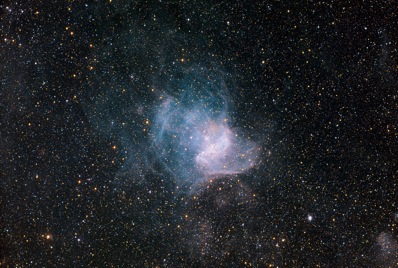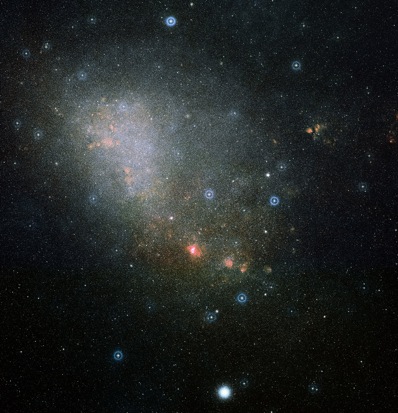
Light, wind and fire
DR EMILY BALDWIN
ASTRONOMY NOW
Posted: 25 February 2010


ESO's latest stellar portrait encapsulates the light, wind and heat given off by massive stars incubating within NGC 346, the brightest star-forming region in our neighbouring galaxy the Small Magellanic Cloud.
 This latest image from ESO of star forming region NGC 346 was captured using the Wide Field Imager instrument at the MPG/ESO 2.2 metre telescope at the La Silla Observatory in Chile. Image: ESO. This latest image from ESO of star forming region NGC 346 was captured using the Wide Field Imager instrument at the MPG/ESO 2.2 metre telescope at the La Silla Observatory in Chile. Image: ESO.
The Small Magellanic Cloud (SMC) is located 210,000 light years away towards the constellation Tucana, and the open cluster of stars that make up NGC 346 spans around 200 light years. NGC 346 is an emission nebula, that is, the gas within it has been heated up by its stellar inhabitants such that it emits its own light. The massive stars' powerful winds disperse the gas to create a wispy cobweb-like structures flowing out from the cluster's dense core.
Many of the cluster's stars are young in cosmic terms – just a few million years old. Their intense winds themselves trigger further star birth by compressing large amounts of matter. These clouds of star-forming ingredients collapse under their own gravity, eventually becoming dense and hot enough to ignite nuclear fusion and become fully fledged stars that also light up the residual debris of gas and dust as colourful beacons in the sky.
 Wide field image of NGC 346 inside the Small Magellanic Cloud, based on data from the Digitized Sky Survey 2. Image: ESO/Digitized Sky Survey 2. Acknowledgements: Davide De Martin. Wide field image of NGC 346 inside the Small Magellanic Cloud, based on data from the Digitized Sky Survey 2. Image: ESO/Digitized Sky Survey 2. Acknowledgements: Davide De Martin.
As more stars form and subsequently blow out their matter they will scatter leftover dust and gas within the cluster, carving out even more ripples and changing the face of their host cluster over time.
Situated relatively close to our home Galaxy, the SMC provides an extragalactic laboratory for astronomers to study star birth and track how growing stars shape their cosmic environment.
|



